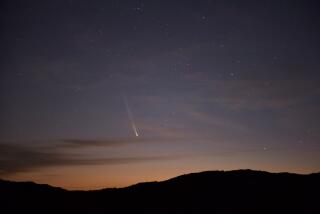2 Stargazers Chance Upon a New Comet
- Share via
CLOUDCROFT, N.M. — An astronomer peering through his home telescope on his driveway noticed a fuzzy blob in the skies that turned out to be a new comet.
“I got very little sleep that night,” said Alan Hale, who has been credited as a co-discoverer of Comet 1995 01.
He was waiting for a known comet to rise early July 23 when he said he turned his 16-inch telescope on a cluster of stars known as M-70 and saw something he knew was not supposed to be there.
Hale, who heads the Southwest Institute for Space Research, checked his sky catalogues to make sure he wasn’t confusing the object with something else.
When he realized he had discovered something new, he sent an electronic message to the International Astronomical Union. The IAU later sent a message confirming Hale’s find, the second comet discovered this year.
That same morning, amateur astronomer Thomas Bopp was gazing at M-70 with a group of friends in the desert south of Phoenix. He also spotted the comet when he was gazing at M-70, and said he reported it to the IAU.
A committee is deciding whether to name the new astral find the Hale-Bopp Comet or the Bopp-Hale Comet, said Brian Mardsen, head of the astronomical union’s Central Bureau for Astronomical Telegrams.
Comets are visible from telescopes on Earth when their orbit around the sun brings them close enough for the sun’s rays to illuminate them.
Mardsen said four to six new comets are found each year, typically by amateur astronomers searching the sky for new objects.
Hale said it is ironic that after spending hundreds of hours searching the sky for a comet, he finally stumbled upon one by accident.
“Now, when I wasn’t really thinking of it, it got dropped into my lap,” he said.
More to Read
Sign up for Essential California
The most important California stories and recommendations in your inbox every morning.
You may occasionally receive promotional content from the Los Angeles Times.













